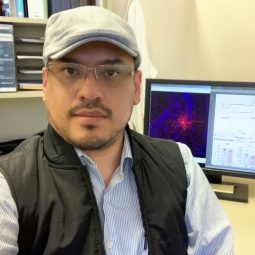Research

Research Scientist, Center for Dementia Research
Helen.Scharfman@nki.rfmh.org
Scharfman Lab Page
Professor,
Departments of Child & Adolescent Psychiatry, Neuroscience & Physiology, and Psychiatry
NYU Grossman School of Medicine
Scharfman NYU Page
Helen.Scharfman@nyulangone.org
Scharfman Lab
Neuronal plasticity and excitability and their relevance to Neurological and Psychiatric Disorders
Research led by Helen E. Scharfman, PhD, in the Scharfman Lab, focuses on mechanisms of neuronal plasticity and excitability and their relevance to neurological and psychiatric disorders. Neuronal plasticity in this context is the ability of the nervous system to adapt and change either to improve our memory or other important functions. Neuronal excitability helps maintain our normal functions and support plasticity. However, in disease plasticity and excitability help us adapt and recover. On the other hand, some diseases “hijack” these processes and can actually contribute to the disease, often called maladaptive plasticity. In some diseases excitability is too low or too high, causing impairments in both situations. When high, the term hyperexcitability is often invoked, and is manifested as highly active neurons and even seizures.
Our laboratories mainly use rodents that simulate what occurs in humans, so called animal models of disease. Some of these models involve a mutation that is found in humans, such as some types of Alzheimer’s disease. Other models involve an initial treatment to a normal animal that leads to some of the characteristics of the disease, such as seizures in epilepsy. Our goals are to devise treatments to utilize mechanisms inherent in the brain to reverse maladaptive plasticity and normalize excitability in rodents. Our intent is to develop new therapeutic approaches for humans.
To understand normal mechanisms of plasticity and excitability, we study may aspects of the brain such as the fundamental circuitry. Our focus is on brain areas important to memory and adapting to our environment such as the hippocampus. In the hippocampus there are neurons that are vulnerable to disease in the hilus of the dentate gyrus, so this is one focus. Some of these hilar neurons, such as mossy cells, have been selectively inhibited or excited and we have shown dramatic effects on normal behavior, as well as effects in a mouse model of epilepsy. In the dentate gyrus there are also neurons that are born during adulthood, a phenomenon that is not present in many brain areas. Our work shows that normally adult-born neurons are important to plasticity and help maintain normal excitability, but in disease they have abnormal characteristics that can contribute to the pathology. Our research uses selective suppression or enhancement of these different types of neurons to treat Alzheimer’s disease models or epilepsy models. Our lab also has developed biomarkers in the EEG in these animal models. They occur very early in life, prior to the observation of plaques and tangles, suggesting they will be potentially very helpful as a non-invasive biomarker in humans.
Research Interests
Dr. Scharfman’s primary research interests include the mechanisms underlying neuronal excitability and neuronal plasticity, neuroendocrinology, and neurogenesis. The emphasis of the laboratory is to understand the basic mechanisms of normal function in order to better address dysfunction, i.e., in neurological disorders and psychiatric illness. An area of long-standing interest has been hippocampus and adjacent brain regions, so there has been an emphasis on learning disorders, as well as epilepsy.
Education
B.A. (Biopsychology), Vassar College, Poughkeepsie, NY
Ph.D. (Pharmacology), Uniformed Services University of Health Sciences, Bethesda, MD
Postdoctoral Training
Postdoctoral Fellow, University of Washington, Neurological surgery. Laboratory of Dr. Philip Schwartzkroin
Research Asociate, Stony Brook University, Neurobiology and behavior. Laboratory of Dr. Paul Adams
Awards and Honors
1991 Phi Beta Kappa, Gen. Honors, Dept. Honors, Rose Fellowship in Biology, Vassar College
1992 NIH FIRST Grant awardee; Epilepsy Foundation Research Grant awardee
1997 Grass lecturer
2004 CURE Scientific Advisory Board
2005 Commissioner’s Recognition Award, NYS Department of Health
2005 Employee of the Year, NYS Department of Health
2006 International League Against Epilepsy, Faculty of 1000
2008 PACE Scientific Advisory Board
2010 NYSTEM IDEA award (with Dr. Rene Hen)
2010 Appointed Associate Editor position, 4th Jasper’s Basic Mechanisms of Epilepsy meeting/book
2011 Elected to Board of Directors, American Epilepsy Society
2012 Alzheimer’s Association, Neuronal Hyperexcitability in Seizures and AD (NHESAD) award
2015 Outstanding Woman in Neuroscience, Inaugural Karen Gale lecture, Georgetown University
2015 Appointed as Reviewing Editor, Journal of Neuroscience
2016 Swammerdam lecturer, University of Amsterdam, The Netherlands
2016 Keynote speaker (elected), University of Alabama, NEURAL conference
2016 CURE Frontiers in Epilepsy Lecture, University of Halifax
2017 Keynote speaker (elected by students), University of Montreal ADENUM conference
2017 Lennox & Lombroso lecturer, American Epilepsy Society
2017 Appointed to Editorial position, 5th Jasper’s Basic Mechanisms of Epilepsy meeting/book
2018 Elected Co-chair, Gordon Research Conference, Mechanisms of Synchronization & Epilepsy
2018 Appointed to Advisory Board, Pyramid Biosciences
2019 Keynote speaker (student-elected), Stony Brook University, Molec. & Cell. Pharmacology
2020 American Epilepsy Society, Research Recognition Award
2020-2021 Scientific Board, Pyramid Biosciences
2022 Appointed to Editorial Review Board, Science Translational Medicine
2022 Appointed as Section Editor of Neurophysiology and Translation, Hippocampus
2022 Appointed to Board of Reviewing Editors, eLife
2022 Consultant, PassageBio
Selected Publications
Botterill JJ, Vinod KY, Gerencer KJ, Teixeira CM, LaFrancois JJ, Scharfman HE. Bidirectional Regulation of Cognitive and Anxiety-like Behaviors by Dentate Gyrus Mossy Cells in Male and Female Mice. J Neurosci. 2021 Mar 17;41(11):2475-2495. PMID: 33472828; PMCID: PMC7984598. Full text
Botterill JJ, Lu YL, LaFrancois JJ, Bernstein HL, Alcantara-Gonzalez D, Jain S, Leary P, Scharfman HE. An Excitatory and Epileptogenic Effect of Dentate Gyrus Mossy Cells in a Mouse Model of Epilepsy. Cell Rep. 2019 Nov 26;29(9):2875-2889.e6. PMID: 31775052; PMCID: PMC6905501. Full text
Scharfman HE. The enigmatic mossy cell of the dentate gyrus. Nat Rev Neurosci. 2016 Sep;17(9):562-75. PMID: 27466143; PMCID: PMC5369357. Full text





